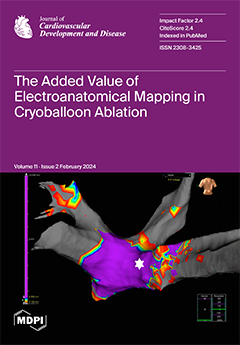Background: Adding electroanatomical left atrial (LA) voltage mapping to cryoballoon ablation (CBA) improves validation of acute pulmonary vein isolation (PVI).
Aims: To determine whether the addition of mapping can improve outcome and PVI durability.
Methods: One-year outcome and PV reconnection (PVR) rate at
[...] Read more.
Background: Adding electroanatomical left atrial (LA) voltage mapping to cryoballoon ablation (CBA) improves validation of acute pulmonary vein isolation (PVI).
Aims: To determine whether the addition of mapping can improve outcome and PVI durability.
Methods: One-year outcome and PV reconnection (PVR) rate at first repeat ablation were studied in 400 AF patients in a propensity-matched analysis (age, AF type, CHA
2DS
2-VASc score) between Achieve catheter-guided CBA with additional EnSite LA voltage maps performed pre- and post-CBA (mapping group; N = 200) and CT- and Achieve catheter-guided CBA (control group; N = 200). Clinical success was defined as freedom of documented AF or atrial tachycardia (AT) > 30 s. PV reconnection patterns were characterized in repeat ablations.
Results: At 1 year, 77 (19.25%) patients had recurrence of AF/AT, significantly lower than in the mapping group: 21 (10.5%) vs. 56 (28%),
p < 0.001. Procedure time was shorter (72.2 ± 25.4 vs. 78.2 ± 29.3 min,
p = 0.034) and radiation exposure lower (4465.0 ± 3454.6 Gy.cm
2 vs. 5940.5 ± 4290.5 Gy.cm
2,
p = 0.037). Use of mapping was protective towards AF/AT recurrence (HR = 0.348; 95% CI 0.210–0.579;
p < 0.001), independent of persistent AF type (HR = 1.723; 95% CI 1.034–2.872;
p = 0.037), and LA diameter (HR = 1.055; 95% CI 1.015–1.096;
p = 0.006). At repeat ablation (N = 90), persistent complete PVI was seen in 14/20 (70.0%) versus 23/70 (32.9%) in the mapping and conventional group, respectively (
p = 0.03). Reconnection rate of the right inferior PV was lower with mapping (10.0% vs. 34,3%,
p = 0.035).
Conclusions: Adding electroanatomical LA voltage mapping to CBA improves 1-year clinical outcome and lowers both procedure time and radiation exposure. At repeat, use of mapping increases complete persistent PVI mainly by improving PVI durability of the RIPV.
Full article






